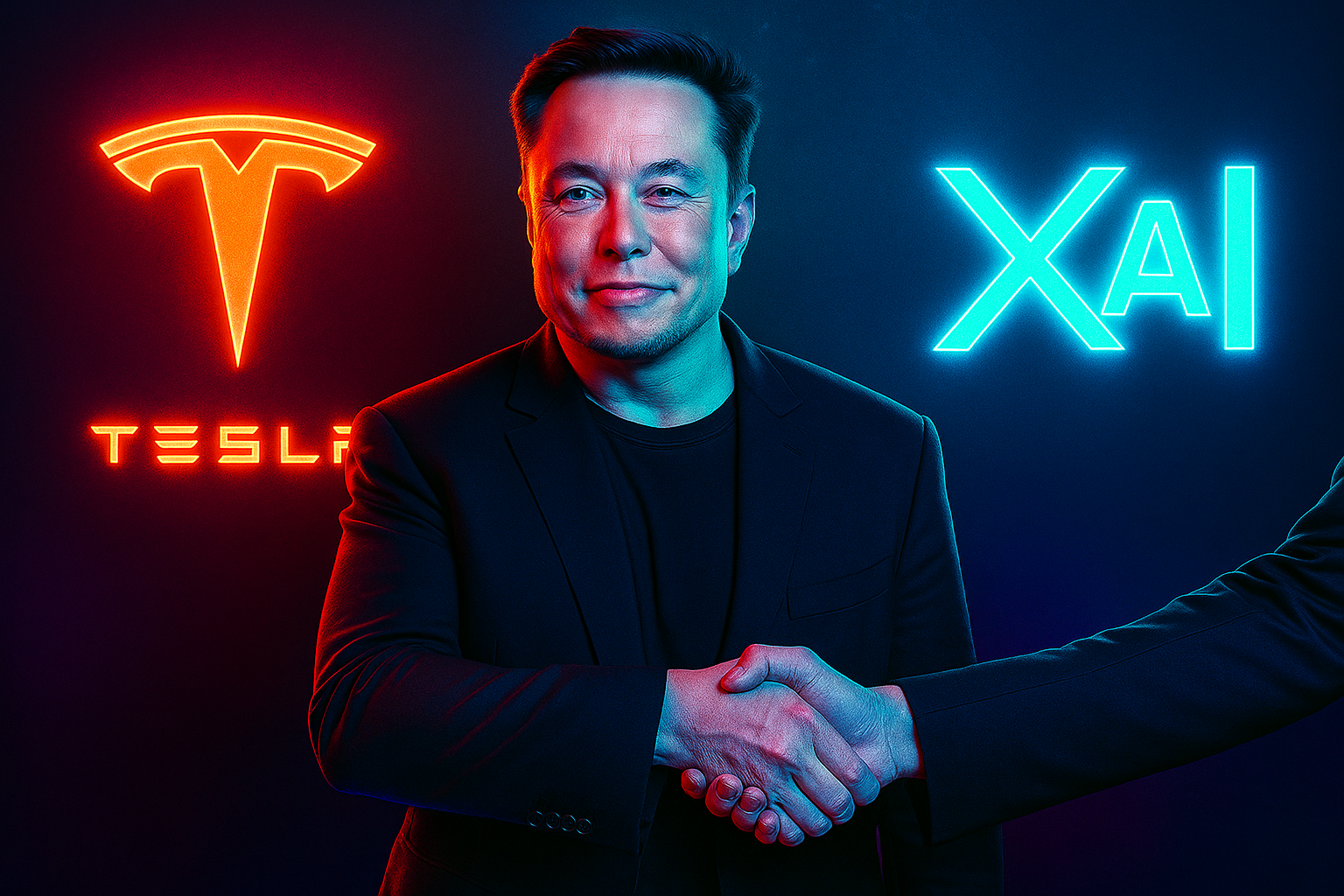
In a world where artificial intelligence is fast becoming the engine of global innovation, few partnerships have attracted as much intrigue and excitement as the collaboration between Tesla and xAI. While both companies are spearheaded by visionary entrepreneur Elon Musk, their convergence marks more than just an alignment of leadership—it signals the birth of a new era where AI and mobility could redefine not just industries, but also the very fabric of our daily lives. For investors, the Tesla-xAI partnership represents an intersection of high-tech potential, competitive risk, and transformative opportunity. Here’s an in-depth look at what this alliance means, and why it matters now more than ever.
The Genesis: Why Tesla and xAI?
Tesla (NASDAQ: TSLA) has long been synonymous with cutting-edge technology, from its industry-leading electric vehicles to its pioneering work in autonomous driving. Yet, as the race for AI supremacy accelerates, the company’s ambitions have grown to encompass not just transportation, but the entire digital ecosystem that surrounds the movement of people and goods.
Enter xAI, Musk’s artificial intelligence startup founded with the mission to “understand the universe.” While still young, xAI is rapidly positioning itself as a direct competitor to OpenAI and Google DeepMind, emphasizing not just generic intelligence, but a suite of capabilities that could be hyper-relevant to Tesla’s goals in autonomy, robotics, and data analytics.
The synergy here is self-evident: Tesla needs ever-more sophisticated AI to achieve true self-driving, optimize manufacturing, and power smart energy solutions, while xAI requires a massive real-world testing ground and troves of data—resources that Tesla can provide in abundance.
High-Tech Synergy: How the Partnership Works
The Tesla-xAI relationship goes far beyond the typical vendor-client or collaborative agreement. Insiders describe it as a deep, symbiotic integration, with xAI’s cutting-edge models being developed, trained, and tested directly within Tesla’s ecosystem.
1. Autonomous Driving
Perhaps the most immediate and obvious benefit is in autonomous driving. Tesla’s Full Self-Driving (FSD) suite, while impressive, still faces regulatory, technical, and safety hurdles. By leveraging xAI’s rapidly evolving large language and vision models, Tesla can enhance its perception, decision-making, and prediction capabilities. Early pilots have shown that xAI’s models can identify complex, rare edge cases—such as ambiguous pedestrian intent or unusual traffic scenarios—better than traditional vision-based AI.
2. Manufacturing and Robotics
Tesla’s factories, especially the Gigafactories, are among the most automated on earth. But there’s still significant room for AI-driven improvement. xAI’s advanced models can be applied to robotics arms, supply chain optimization, and predictive maintenance, leading to more efficient operations and fewer costly interruptions. Moreover, the integration of xAI’s natural language models allows human operators to interface with factory systems in more intuitive, voice-driven ways, streamlining troubleshooting and maintenance.
3. Energy and Infrastructure
Tesla’s ambitions with its Energy division—Powerwall, Powerpack, and the new Megapack—are not limited to storage. The company wants to build smart, responsive energy grids powered by AI-driven prediction and management. xAI’s analytical prowess can optimize energy flow, balance supply and demand, and even forecast grid failures before they occur, enabling a cleaner, more reliable energy network.
4. Data Advantage and Reinforcement Learning
With millions of cars on the road and thousands of robots in operation, Tesla’s trove of real-world data is an unparalleled asset for xAI’s model training. This continuous data feedback loop helps xAI iterate its models far faster than competitors dependent on synthetic or lab-based data. In turn, this keeps Tesla’s technology at the bleeding edge, creating a virtuous cycle of improvement.
What’s in It for Investors?
Growth Acceleration
The Tesla-xAI partnership turbocharges Tesla’s growth prospects in two crucial sectors: mobility and AI. By integrating proprietary, best-in-class AI, Tesla gains a significant edge over traditional automakers and tech companies alike. This can accelerate the timeline to full autonomy—potentially unlocking new business models such as robotaxi networks, AI-driven logistics, and automated manufacturing that could drive exponential revenue growth.
New Business Lines
xAI itself is likely to commercialize its technology beyond Tesla. Investors should watch for announcements regarding xAI’s AI as a Service (AIaaS) platforms, enterprise solutions, or licensing deals. Tesla’s early and deep integration means it will always have first access to the latest breakthroughs.
Competitive Moat
In an era where software and AI are becoming the differentiators in hardware-driven industries, Tesla’s access to and co-development of xAI’s models gives it a wide moat. Competitors like Waymo, Apple, and legacy automakers may struggle to match the speed and depth of AI innovation that this partnership can deliver.
Potential Risks
No high-tech synergy comes without risk. xAI is still a startup; if its models fail to deliver, or if regulatory scrutiny on AI intensifies, Tesla’s reliance could become a vulnerability. There’s also the risk that rapid advances in AI could lead to ethical concerns, regulatory pushback, or even market disruptions that harm both companies.
The Market Reaction and Analyst Views
Since the formal announcement of deeper integration, analysts have been broadly bullish, citing not just technological potential but the value of Musk’s unified vision. Wall Street has adjusted upward its estimates of Tesla’s long-term margins and market share, while also increasing its price targets on the prospect of successful full autonomy. Some hedge funds, however, have warned that the “hype premium” could be short-lived if real-world results fail to match expectations.
What to Watch Going Forward
- Product Milestones: Watch for Tesla FSD updates that cite xAI advancements, as well as AI-powered features in Tesla Energy products.
- Commercialization of xAI: Keep an eye on xAI’s moves to enter non-Tesla verticals.
- Regulatory Landscape: Both companies are pushing into frontiers where regulation is still evolving; changes here could have outsized impact.
- Talent and Retention: The battle for AI talent is heating up—Tesla and xAI’s ability to attract and retain top minds will be crucial.
- Data Privacy and Security: With massive amounts of data flowing between the two companies, robust privacy and security measures will be essential to avoid backlash.
Conclusion
The Tesla-xAI partnership is one of the most compelling high-tech alliances of the decade. It promises to accelerate innovation not just in electric vehicles, but across robotics, energy, and beyond. For investors, it represents both a bold opportunity and a complex challenge. As with all things Musk, the upside is enormous—but so too are the risks. Those who keep a close eye on this evolving story may find themselves ahead of the curve as the age of AI-powered mobility dawns.
Disclaimer:
This article is for informational purposes only and does not constitute financial advice or a recommendation to buy or sell any securities. Investing in technology stocks involves risks, including potential loss of principal. Always conduct your own research and consult with a licensed financial advisor before making investment decisions.






